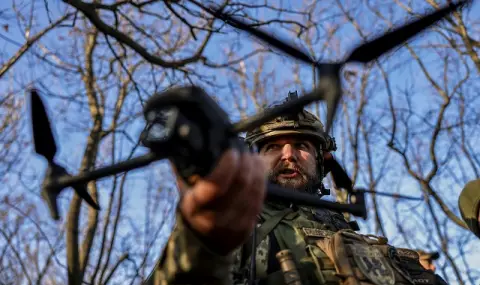Ukrainian Defense Minister Rustem Umerov announced the Ukrainian "Drone Line" project as part of Ukraine's ongoing efforts to integrate drone operations and ground operations.
This is what the Institute for the Study of War (ISW) wrote in its daily analysis.
Ukraine's efforts to integrate drone operations with ground operations differ significantly from Russia's efforts to centralize drone units.
Umerov said that the Ukrainian military will "increase" the five existing drone regiments and brigades in the Ukrainian military and border service and will integrate infantry and drones into a single strike system.
This will allow Ukrainian forces to create strike zones 10-15 km deep.
In addition, it will provide constant air support and cover for infantry and detect and destroy Russian forces before they can approach Ukrainian positions.
The Ukrainian Ground Forces announced that the expansion of five such existing drone units is only the first stage of the "Drone Line" project.
This project officially provides additional support to ongoing Ukrainian efforts to expand drone units and increase their coordination with regiments and brigades, while regular units and drone units are separated to facilitate faster combat and technological adaptation and innovation of drone units.
Russia's efforts to centralize drone units attempt to increase Russian drone capabilities by expanding state control over drone operators and developers and by strengthening their integration into the Russian military bureaucracy.
In the fall of 2024, the Russian military began efforts to centralize drone operators and developers by disbanding unofficial Russian drone units and withdrawing drone specialists from regular military units, then selectively reorganizing them into new drone units controlled by the Russian Ministry of Defense (MOD) and centralizing their assets.
It was also reported that in January 2024 The Russian MoD has created its first separate drone regiment at the military district level, further highlighting ongoing efforts to centralize and bureaucratize control over drone operations.
ISW continues to assess that the Russian MoD’s efforts to centralize and reorganize drone units and monopolize drone production and procurement processes could complicate the ability of Russian forces to rapidly innovate and adapt new technologies and combat techniques in the short and medium term.
Ukrainian forces continue to attack oil refineries in Russia as part of an ongoing campaign to strike Russian defense industrial enterprises and oil refineries.
Russian authorities reportedly authorized the systematic torture of Ukrainian prisoners of war held in Russian prisons as early as March 2022. d.
The Kremlin may be creating information conditions to justify an influx of North Korean citizens arriving in Russia to join the Russian workforce or the Russian military.
A Russian official claims that Russia is sending experienced Russian military personnel to North Korea for medical treatment.
Russian military bloggers continue to complain about the systemic problem of Russian forces submitting false reports to Russian military authorities and manipulation by high-ranking Russian officers.
Ukrainian forces have recently advanced near Pokrovsk.
Russian forces have recently advanced in the Kursk region and near Chasov Yar, but also Pokrovsk.
